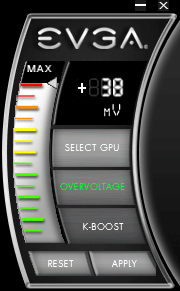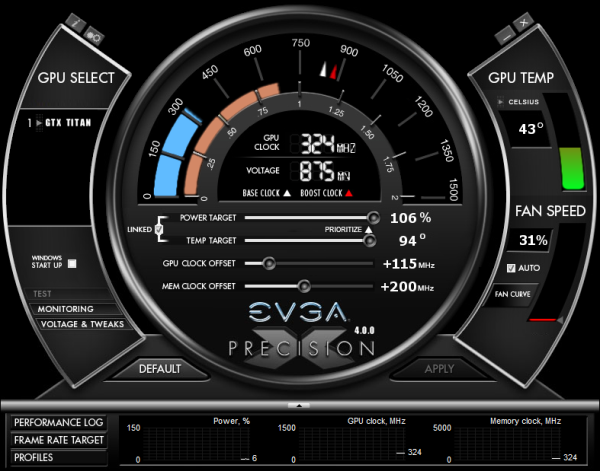NVIDIA’s GeForce GTX Titan Review, Part 2: Titan's Performance Unveiled
by Ryan Smith & Rahul Garg on February 21, 2013 9:00 AM ESTThe Final Word On Overclocking
Before we jump into our performance breakdown, I wanted to take a few minutes to write a bit of a feature follow-up to our overclocking coverage from Tuesday. Since we couldn’t reveal performance numbers at the time – and quite honestly we hadn’t even finished evaluating Titan – we couldn’t give you the complete story on Titan. So some clarification is in order.
On Tuesday we discussed how Titan reintroduces overvolting for NVIDIA products, but now with additional details from NVIDIA along with our own performance data we have the complete picture, and overclockers will want to pay close attention. NVIDIA may be reintroducing overvolting, but it may not be quite what many of us were first thinking.
First and foremost, Titan still has a hard TDP limit, just like GTX 680 cards. Titan cannot and will not cross this limit, as it’s built into the firmware of the card and essentially enforced by NVIDIA through their agreements with their partners. This TDP limit is 106% of Titan’s base TDP of 250W, or 265W. No matter what you throw at Titan or how you cool it, it will not let itself pull more than 265W sustained.
Compared to the GTX 680 this is both good news and bad news. The good news is that with NVIDIA having done away with the pesky concept of target power versus TDP, the entire process is much simpler; the power target will tell you exactly what the card will pull up to on a percentage basis, with no need to know about their separate power targets or their importance. Furthermore with the ability to focus just on just TDP, NVIDIA didn’t set their power limits on Titan nearly as conservatively as they did on GTX 680.
The bad news is that while GTX 680 shipped with a max power target of 132%, Titan is again only 106%. Once you do hit that TDP limit you only have 6% (15W) more to go, and that’s it. Titan essentially has more headroom out of the box, but it will have less headroom for making adjustments. So hardcore overclockers dreaming of slamming 400W through Titan will come away disappointed, though it goes without saying that Titan’s power delivery system was never designed for that in the first place. All indications are that NVIDIA built Titan’s power delivery system for around 265W, and that’s exactly what buyers will get.
Second, let’s talk about overvolting. What we didn’t realize on Tuesday but realize now is that overvolting as implemented in Titan is not overvolting in the traditional sense, and practically speaking I doubt too many hardcore overclockers will even recognize it as overvolting. What we mean by this is that overvolting was not implemented as a direct control system as it was on past generation cards, or even the NVIDIA-nixed cards like the MSI Lightning or EVGA Classified.
Overvolting is instead a set of two additional turbo clock bins, above and beyond Titan’s default top bin. On our sample the top bin is 1.1625v, which corresponds to a 992MHz core clock. Overvolting Titan to 1.2 means unlocking two more bins: 1006MHz @ 1.175v, and 1019MHz @ 1.2v. Or put another way, overvolting on Titan involves unlocking only another 27MHz in performance.

These two bins are in the strictest sense overvolting – NVIDIA doesn’t believe voltages over 1.1625v on Titan will meet their longevity standards, so using them is still very much going to reduce the lifespan of a Titan card – but it’s probably not the kind of direct control overvolting hardcore overclockers were expecting. The end result is that with Titan there’s simply no option to slap on another 0.05v – 0.1v in order to squeak out another 100MHz or so. You can trade longevity for the potential to get another 27MHz, but that’s it.
Ultimately, this means that overvolting as implemented on Titan cannot be used to improve the clockspeeds attainable through the use of the offset clock functionality NVIDIA provides. In the case of our sample it peters out after +115MHz offset without overvolting, and it peters out after +115MHz offset with overvolting. The only difference is that we gain access to a further 27MHz when we have the thermal and power headroom available to hit the necessary bins.
| GeForce GTX Titan Clockspeed Bins | |||
| Clockspeed | Voltage | ||
| 1019MHz | 1.2v | ||
| 1006MHz | 1.175v | ||
| 992MHz | 1.1625v | ||
| 979MHz | 1.15v | ||
| 966MHz | 1.137v | ||
| 953MHz | 1.125v | ||
| 940MHz | 1.112v | ||
| 927MHz | 1.1v | ||
| 914MHz | 1.087v | ||
| 901MHz | 1.075v | ||
| 888MHz | 1.062v | ||
| 875MHz | 1.05v | ||
| 862MHz | 1.037v | ||
| 849MHz | 1.025v | ||
| 836MHz | 1.012v | ||
Finally, as with the GTX 680 and GTX 690, NVIDIA will be keeping tight control over what Asus, EVGA, and their other partners release. Those partners will have the option to release Titan cards with factory overclocks and Titan cards with different coolers (i.e. water blocks), but they won’t be able to expose direct voltage control or ship parts with higher voltages. Nor for that matter will they be able to create Titan cards with significantly different designs (i.e. more VRM phases); every Titan card will be a variant on the reference design.
This is essentially no different than how the GTX 690 was handled, but I think it’s something that’s important to note before anyone with dreams of big overclocks throws down $999 on a Titan card. To be clear, GPU Boost 2.0 is a significant improvement in the entire power/thermal management process compared to GPU Boost 1.0, and this kind of control means that no one needs to be concerned with blowing up their video card (accidentally or otherwise), but it’s a system that comes with gains and losses. So overclockers will want to pay close attention to what they’re getting into with GPU Boost 2.0 and Titan, and what they can and cannot do with the card.











337 Comments
View All Comments
CeriseCogburn - Monday, March 4, 2013 - link
That's all you've got ?Did you at least look at the links, or have a failed brainfart of an idea for a rebuttal ?
No, of course you did not. Another mindless, insulting fool, without a single anything other than of course, and insult.
I would feel better about agreeing with you if you had any facts or even an opinion on anything else.
swing848 - Friday, May 17, 2013 - link
I believe the review was for gaming machines. In that regard HD 7970s and GTX 680s trade blows as one card is faster in some games and the other faster in some games.So, gamers should pick a card that will perform the best for the games they play.
Microsoft FSX is very old now, yet a person needs a very powerful gaming computer to run it with all of the goodies turned up [with lots of code fixes], including overclocking an Ivy Bridge to 4.5GHz+ [this is because when the game was developed it was believed that Moore's Law was valid and single core CPUs would be running at 10GHz by 2012]. And, yes, FSX was coded for NVIDIA.
coilpower - Thursday, February 21, 2013 - link
Well that is where nvidia's attempted marketing falls apart. Compute in their flagship gpu brought to geforce lineup is nothing new. Now they think they can go $1000 on it, doubling the price.Techpowerup was apt when they said this is the most overpriced video card in 25 years.
Nvidia has dropped the ball here on the price, heck, they have thrown it down the street. Too bad, now they will lose more face with the price drops needed to get these off shelves.
CeriseCogburn - Saturday, February 23, 2013 - link
They're sold out, already.So much for you being correct, you're already an incorrect failure.
Nice try amd fansvengaliboy
Alucard291 - Sunday, February 24, 2013 - link
All 100 of them? :)CeriseCogburn - Tuesday, February 26, 2013 - link
You forgot the k fool.Alucard291 - Friday, March 8, 2013 - link
Proof? :)In any case, please stop shitposting. This is not 4chan or engadget.
CeriseCogburn - Tuesday, March 12, 2013 - link
They're still sold out, ROFL.CeriseCogburn - Thursday, March 21, 2013 - link
From Anand Brain etc in the current article: " 12:16PM EDT - GK110 in general seems to be supply constrained right now. NVIDIA has previously told us they're selling every Tesla K20 and Titan card they can make""Thank you Cerise, I'm sorry, I Alutard291 was wrong, and you are right. I challenged you and lost miserably. In the future I will shut my lying piehole and learn from you, Cerise, instead."
LOL - No you won't Alutard, you will never be correct.
CeriseCogburn - Saturday, February 23, 2013 - link
$4500 from appreciative clients, or a grand from whining disgruntled crybabies ?Hmmm... what should a company do... ?
http://www.excaliberpc.com/622885/nvidia-tesla-k20...
I think they should take the extra $3500, and let the crybabies squeal and wail and fill their diapers.